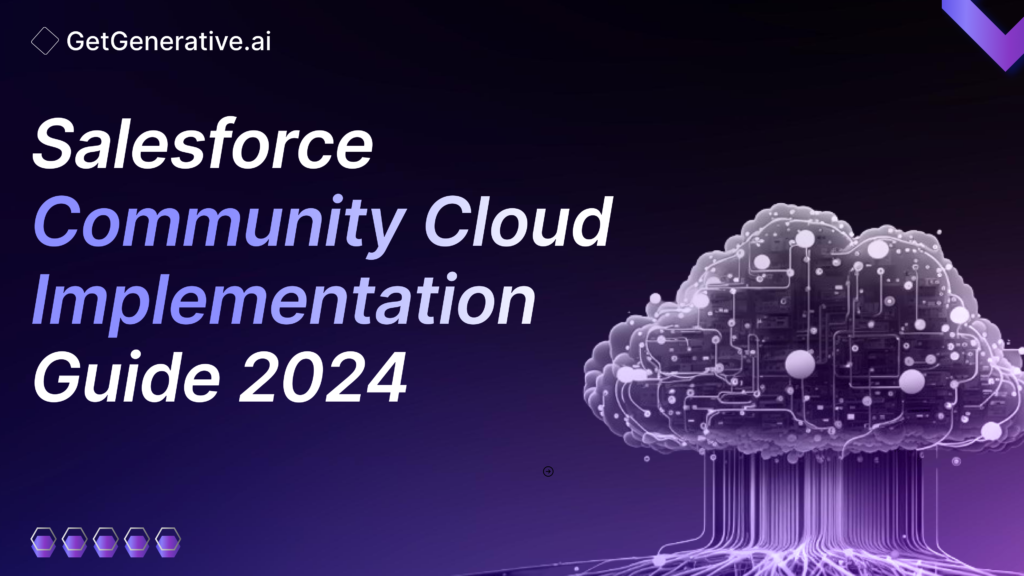Salesforce Community Cloud Implementation Guide 2024
Research indicates that organizations leveraging Community Cloud not only enhance user engagement by up to 45% but also see a significant 30% increase in customer loyalty. These improvements aren’t automatic; they result from thoughtful planning, strategic implementation, and ongoing community management.
Implementing Salesforce Community Cloud begins with a foundational understanding of its capabilities and how it aligns with your organizational goals.
Let’s start with the basics first.
What is Salesforce Community Cloud?
Salesforce Community Cloud is a powerful digital experience platform that enables companies to connect with customers, partners, and employees. It combines the real-time collaboration of social networks with the business processes of a traditional CRM. The platform allows users to share information, collaborate on projects, and collectively solve problems, enhancing engagement and satisfaction.
Core Functionalities:
- Collaboration: Streamline communication across your organization and external stakeholders.
- Personalization: Tailor experiences for users based on roles, interests, and behaviors.
- Integration: Seamlessly connect with Salesforce’s suite of products and third-party applications.
- Mobile-optimized: Ensure a consistent and engaging user experience across all devices.
Key Features of Community Cloud:
- Customizable Templates: Use pre-built or custom templates to create communities that cater specifically to your audience.
- Lightning Community Builder: A drag-and-drop interface that allows you to create rich, dynamic communities without needing extensive technical knowledge.
- Einstein AI: Leverage artificial intelligence to provide personalized recommendations, content, and insights to community members.
- Salesforce CMS: Salesforce CMS helps create, manage, and publish content directly within the community, ensuring a consistent and integrated user experience.
Planning Your Community Strategy
Before launching into the technical setup, it’s critical to have a strategic plan:
- Define Objectives: Clearly outline what you want to achieve with your community. Objectives can range from improving customer support to fostering partner networks or employee collaboration.
- Identify the Audience: Determine who your community will serve. Understanding the audience helps tailor the community design to meet specific needs and preferences.
- Community Management Team: Assemble a team responsible for managing the community. This team should include roles such as community managers, content creators, and technical support.
- Content and Engagement Plan: Develop a plan for ongoing community engagement through regular content updates, forums, Q&A sessions, and more.
- Feedback Mechanisms: Implement tools and processes to gather feedback from community members. This will be crucial for continuous improvement.
Setting Up a Project Timeline
Creating a timeline is essential to ensure a smooth implementation:
- Phase 1: Preparation and Planning (1-2 months): Define the project scope, objectives, and gather requirements.
- Phase 2: Design and Development (2-3 months): Customize the community layout, set up necessary integrations, and populate with initial content.
- Phase 3: Pilot Testing (1 month): Run a pilot with a select group of users to collect feedback and make adjustments.
- Phase 4: Launch (1 month): Go live with the community and monitor its performance closely.
- Phase 5: Ongoing Management and Iteration: Post-launch, enter a phase of regular assessment, updates, and user engagement.
Each of these steps prepares an organization to not only launch but sustain a thriving Salesforce Community Cloud environment that meets the dynamic needs of its users while aligning with business goals.
Technical Setup and Configuration
Setting up Salesforce Community Cloud involves several technical steps to ensure the platform is configured correctly and tailored to your organization’s needs. Here’s a comprehensive look at the process:
Choosing the Right Template
Salesforce Community Cloud offers a variety of templates, each designed for different types of communities, such as Customer Service, Partner Relationship, or Employee Engagement. Choosing the right template is critical as it provides the foundational layout and features suited to your specific type of community.
- Customer Service Template: Ideal for support communities where customers can ask questions, find answers, and engage with support representatives.
- Partner Central Template: Best for partner communities, facilitating joint business planning, lead registration, and sales collaboration.
- Employee Community Template: Suitable for intranet-type communities where employees can access organizational resources, news, and collaboration tools.
Customizing the Look and Feel
After selecting a template, the next step is to customize the community to reflect your brand and meet your specific functional needs. This includes:
- Branding: Apply your organization’s logo, color scheme, and branding elements to the community to maintain brand consistency.
- Navigation: Configure the navigation menus to ensure users can easily find information and resources. This might involve customizing the main menu and footer links.
- Pages and Layouts: Using the Lightning Community Builder, you can drag and drop components to design and arrange pages. This tool allows for the addition of custom pages and the adjustment of layouts to better suit your audience.
Setting Up User Roles and Permissions
Managing user access is crucial for maintaining the security and relevance of the community. Salesforce provides robust options for setting up roles and permissions:
- Roles: Define different roles for community members based on their interaction level and the type of content they should access. For example, a customer might have different access rights compared to a partner or an employee.
- Permissions: Set permissions to control who can view, create, edit, or delete content within the community. Permissions can be set for different types of content like posts, comments, files, and administrative settings.
Integrating Salesforce and Third-party Applications
To maximize the effectiveness of your Community Cloud, integrating with other Salesforce applications and external systems is key:
- Salesforce Integration: Seamlessly connect the community with Salesforce CRM, Service Cloud, or Marketing Cloud for a unified approach to customer relationship management.
- Third-party Integration: Use Salesforce’s robust API to integrate with external applications like ERP systems, marketing automation tools, or custom applications. This integration is essential for providing a comprehensive experience that leverages existing business processes and data.
Mobile Optimization
With the increasing use of mobile devices, ensuring your community is mobile-optimized is a must:
- Responsive Design: Ensure the community design adjusts seamlessly to different screen sizes and resolutions.
- Mobile App Integration: Salesforce offers the Salesforce Mobile App, which can be customized to include community functionality, allowing users to engage with the community directly from their mobile devices.
Testing and Validation
Before going live, it’s crucial to thoroughly test the community setup:
- Functionality Testing: Check all features and functionalities to ensure they work as expected.
- User Acceptance Testing (UAT): Involve a group of end-users to test the community in real-world scenarios and provide feedback.
- Security Testing: Verify that all security measures, including access controls and data protection mechanisms, are functioning properly.
By carefully selecting the right template, customizing the community to reflect your brand, setting appropriate user roles and permissions, and ensuring seamless integrations, you can create a dynamic and engaging platform that significantly enhances collaboration and interaction among stakeholders.
Also Read – Salesforce B2B Commerce Implementation Guide 2024
Integration Strategies
Integrating Salesforce Community Cloud effectively with other systems is crucial for maximizing its value and ensuring a seamless user experience. Here’s how to approach integration strategically:
Integrating with Salesforce Products
One of the major benefits of Salesforce Community Cloud is its ability to integrate effortlessly with other Salesforce products, such as:
- Salesforce CRM: Synchronize data between CRM and the community to ensure consistency in customer information and interactions.
- Salesforce Service Cloud: Allow community users to access support tools, creating a self-service portal that can reduce support costs and increase customer satisfaction.
- Salesforce Marketing Cloud: Use customer interactions and behaviors from the community to trigger personalized marketing campaigns and track their effectiveness.
External Integrations
Beyond Salesforce products, integrating Community Cloud with external systems can enhance its functionality:
- ERP Systems: Connect with enterprise resource planning systems to bring in business process functionalities, such as order management or inventory checks, directly into the community.
- Social Media Platforms: Integrate social media to allow users to log in with their social media accounts and share content directly from the community to their networks.
- Custom Applications: Utilize Salesforce’s APIs to integrate with bespoke applications specific to your industry or business needs, enhancing the community’s capabilities.
Security Considerations
Security is a paramount concern when deploying any digital solution that handles user data. Here are essential security considerations for Salesforce Community Cloud:
Ensuring Data Privacy
Protect sensitive user information by implementing robust data privacy measures:
- Data Encryption: Use Salesforce’s built-in data encryption options to secure data at rest and in transit.
- Privacy Policies: Clearly communicate your data privacy policies within the community, ensuring transparency about how user data is collected, used, and protected.
Compliance and Regulatory Issues
Stay compliant with international, national, and industry-specific regulations:
- GDPR and CCPA Compliance: Ensure that your community adheres to regulations like the GDPR in Europe and the CCPA in California, especially concerning user data rights and privacy.
- Industry Standards: Follow industry-specific standards and practices, particularly if you operate in regulated sectors like finance, healthcare, or education.
Also Read – Salesforce Implementation With AI Guide 2024
Maintenance and Ongoing Support
Keeping your community well-maintained and supported is critical to its long-term success:
Regular Updates and Upgrades
Stay updated with the latest Salesforce releases and security patches to protect your community from vulnerabilities and ensure it benefits from the latest features.
Providing User Support
Offer comprehensive support options, such as FAQs, helpdesk services, and user forums, to resolve user issues promptly and maintain a smooth operation.
Final Thoughts
Implementing Salesforce Community Cloud can transform how your organization engages with customers, partners, and employees. By following the outlined strategies for integration and security, you can create a robust, engaging, and secure community. Continuously evolving with technological advancements and user feedback is crucial to maintaining an effective digital community space.
For more insights and assistance in harnessing the power of generative AI and Salesforce solutions, visit getgenerativeai.com today!


